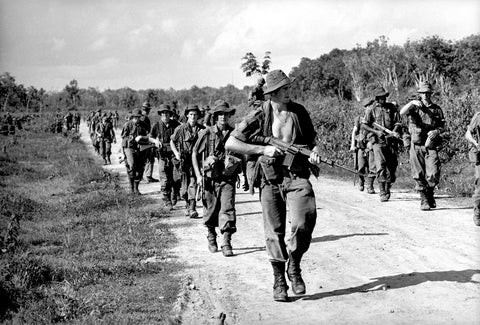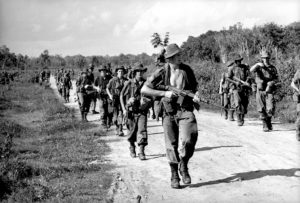
Why Were Australian Vietnam Veterans Treated Shamefully?

While I knew that Australia had sent troops to Vietnam, I had no idea that their returning combat veterans were treated as shamefully as they were here in the U.S. (Intel, “Australia Set to Commemorate War’s End,” April 2022). What was it that made this such a universal response when we should have been proud of them? Was this an independent action on the part of civilian Australians or was it learned from American media? Also, were the Vietnam combat veterans who returned to England treated in the same shameful way?
Shelby Morrison – Orlando, Florida
Thank you for your questions, and for your interest in learning more about the experiences of Australian Vietnam veterans.
A total of 60,000 Australians served in Vietnam, and faced many of the same challenges experienced by American servicemen upon returning home. Given the national and cultural differences between Australia and the United States, veterans’ experiences varied between the two nations, and societal opposition to the Vietnam War expressed itself in different ways. However, the Vietnam War became increasingly unpopular over time in both countries, and servicemen reported being shunned and mistreated by others after they returned home.
Q: What was it that made this such a universal response when we should have been proud of them? Was this an independent action on the part of civilian Australians or was it learned from American media?
Opposition to the Vietnam War formed in Australia for several key reasons. From the war’s outset, sentiments existed among some quarters of the public that the country was being dragged into an American conflict contrary to its own national interests. These feelings increased in the public sphere over time as the war continued.
Another factor was the introduction of the draft. In 1964, a conscription “lottery” scheme was put into action, by which 20-year-old Australian men were chosen via the selection of numbered marbles. Upon being chosen, each man was required to serve two years full time in the Australian Army, plus an additional three and a half years part-time. The draft was unpopular and drew opposition from members of the public.
Television played a key role in shaping public perceptions of the war. As in the United States, many Australians were alarmed by grisly images and scenes of suffering and destruction they witnessed in television news reports. The year 1968 marked a turning point in public attitudes toward the conflict. The Tet Offensive increased opposition to the draft.
“Horrific scenes on television screens … sapped public support further,” according to Neil Sharkey, curator of Australia’s Shrine of Remembrance in Melbourne.
Many people were also deeply shaken by the atrocities committed during the My Lai Massacre. According to the National Museum of Australia, “the Australian public began to think that if American soldiers were doing this sort of thing then possibly their Australian comrades were doing the same.”
Growing public outrage at the war, and coverage of protests in American cities, inspired Australians to gather in protest rallies known as “moratoriums.”
“An Australian anti-war movement gathered momentum, and by 1970-71, hundreds of thousands of people were attending Moratorium [protest] marches across Australia …. Soldiers returning to Australia met a hostile reception,” wrote Sharkey.
Over the years, Australian veterans have reported being insulted and subjected to discriminatory treatment after returning home from Vietnam.
Rejected by fellow soldiers, ignored by the government
Veterans also endured a particularly painful form of ostracism — mistreatment by other military veterans. This manifested itself in exclusion from social clubs for veterans commonly known as RSL clubs (Returned and Services League of Australia) clubs. As a nation, Australia had developed a distinct sense of pride in its troops’ achievements in World Wars I and II. Yet some World War II veterans treated their countrymen who fought in Vietnam with disdain, adopting the attitude that Australian troops who fought in Vietnam were merely a sideshow to the American military and that it was “not a real war.”
“We were ostracized by not only the civilians but also the RSL and everybody else,” said Peter Safe, who served in Vietnam in the 9th Battalion, Royal Australian Regiment, in an interview with Australia’s ABC news. “According to the RSL, that wasn’t a war zone, it was just police action…it took a while for them to come to grips with it and [it to] be recognized as a war.”
Additionally, the potential exposure of Australian veterans to Agent Orange and chemical defoliants in Vietnam was a hotly contested issue. Initially, the Australian government flatly denied that any veterans had been exposed to chemical defoliants. In response, Australian veterans fought fiercely for recognition and eventually were able to claim compensation for illnesses resulting from herbicides and pesticides.
The Australian government has recently stepped up its efforts to honor the service of Vietnam veterans.
Despite the similarities in their postwar experiences, Australian and American veterans had distinctly different experiences in the field. For example, unlike American servicemen, Australian soldiers were not impacted by social tensions related to the Civil Rights movement. Drug use was not a widespread problem among Australian conscripts, although alcohol abuse became a major issue in the war’s later stages.
Q: Were the Vietnam combat veterans who returned to the UK treated in the same way?
England’s military involvement in the Vietnam War was extremely limited. As in Australia, some members of the British public were concerned that becoming involved in the war was against their national interests and wished to avoid their leadership “being a mere satellite of the U.S.,” as American diplomat David K.E. Bruce put it in 1965. Officially, British involvement in Vietnam ceased in January 1946, after the British military helped to restore French colonial rule in the aftermath of World War II.
However, British intelligence advisers are said to have provided assistance to U.S. and Australian troops in Vietnam in the form of covert operations. Therefore, Britain did provide aid in the struggle while avoiding media scrutiny and high levels of public opposition.
It should also be noted that, despite the comparative lack of troops on the ground, some British soldiers voluntarily joined the fight in Vietnam after moving to the United States or to other countries supporting the war effort. Bob Rose of Birmingham, England, served in the French Foreign Legion and eventually the South Vietnamese Army alongside the U.S. military. Additionally, the U.S. soldier whose photo became famous on the cover of Hal Moore’s book “We Were Soldiers Once … And Young,” was actually British. Rick Rescorla, a native of Cornwall, served in the British Army before moving to the U.S. and joined the U.S. Army to fight in Vietnam. Rescorla remained in the U.S. after the war and went on to lead people to safety at the World Trade Center during the 9/11 terrorist attacks, saving an estimated 2,687 lives and sacrificing his own in the process.
Aside from the United States and Australia, another country whose Vietnam veterans experienced widespread mistreatment upon returning home was New Zealand.
“A lot of veterans who came home were just advised to get out of uniform and disappear,” according to Claire Hall, writer, historian and archivist for New Zealand’s Ministry for Culture and Heritage.
The country experienced heated antiwar demonstrations, with a police inspector in Auckland being pushed off a cliff by protesters. New Zealand’s government issued a formal apology to Vietnam veterans for mistreatment in 2008.
